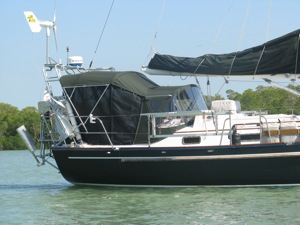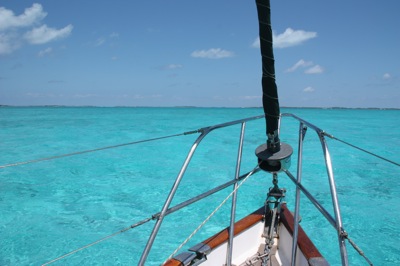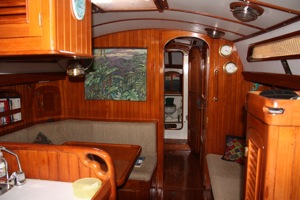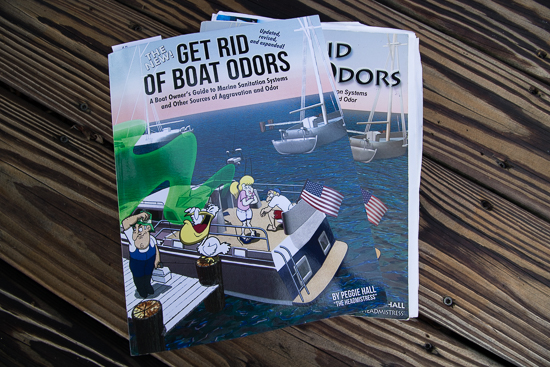Every few years, our insurance requires an in-the-water survey, known as a “condition and valuation” survey. The purpose of the survey is to make sure the boat is still in good condition and not a huge risk to the insurance company. Don’t confuse this survey with a “pre-purchase” survey which is much more extensive and includes a sea-trial and testing of equipment and systems.

First step is to find a competent and fair accredited surveyor. A bad surveyor can cause you no end of misery by citing insignificant “recommendations” which will have to be corrected before the insurance company will renew the insurance. We checked the SAMS (Society of Accredited Marine Surveyors) website as well as asked around the marina for a competent and fair surveyor.

The insurance condition and valuation survey evaluates the boat, including through hull fittings and plumbing, fuel, exhaust and electrical systems, rigging, and electronics (no testing) and all systems installed aboard. They don’t turn on stuff, like the watermaker or radar to make sure they work, they just ask.
Our surveyor was very thorough. We turned on the navigation lights, he opened every floorboard, checked the diesel, checked the electrical systems, looked specifically for signs of water intrusion – after all, Winterlude is almost 30 years old and he said it was very rare to find a boat this old that is “dry” …. knock on wood! He noted all our equipment, checked our flares and fire extinguishers, asked tons of questions, made a pencil tracing of our boat’s hull number, looked at the documentation number inside and after a couple of hours, complimented us on knowing our boat, inside and out.

Preparing the boat for the survey is the owner’s responsibility. Here are a few tips:
1. Never forget to make a good first impression. Curb appeal is as important in a boat survey as it is in real estate. Get the boat cleaned up and make her look as appealing as possible! Clean the waterline, the stainless, anything that could detract from that all important initial first impression.
2. Take extraneous stuff out of the way. Our dinghy lives on the foredeck and the kayaks live on the side rails. We took all three off the boat. We also moved anything that might be in the way – for example enough stuff out of the quarterberth to allow access to the side panel of the diesel.
3. We also made sure all the cabin sole openings were easily available, as well as access to the water and diesel tanks.
4. Make a list ahead of time to insure if the surveyor doesn’t specifically ask about important equipment aboard – perhaps storm sails stored, an extra genoa, a spinnaker, our watermaker,, anything that adds value and makes the boat more seaworthy, or maybe cruiseworthy — if you have extra anchors or a spare propeller stored etc. Make sure to mention them.
5. He/she will need to know the make and model of all your stuff — especially the diesel, transmission, what your tanks are made of, how many gallons they are, technical specifications about your keel/shaft/prop configuration, etc. So make sure you know ahead of time, it’ll speed the process.
6. Be sure to mention any recent upgrades you’ve made such as our rebuilt windlass, our 2011 new cockpit enclosure, last winter’s head replacements, new anchor chain, anything relevant.

7. If you know there’s something systemwise that’s not operational, you may want to make sure it’s working before the survey.
8. On older boats, a surveyor will especially be looking for water intrusion and water damage. If you have any places where water damage has occurred, consider fixing it and making sure the leak is history before the survey.
We’re celebrating tonight because Winterlude passed with flying colors – pending the final report, of course, But a good surveyor will go through with you what he’s going to list as things the insurance company is probably going to require proof of repair or replacement before they’ll renew your insurance and also his list of things you might want to consider.
We need to replace our fire extinguishers – because they’re out of date, not because they’re not still in the green, grumble, redo our mast boot and add a smoke detector. He also thought it would be a good idea for us to add a high water alarm, but it’s not a requirement.
WooHoo, Celebration time! You never know what to expect, especially with a boat almost 30 years old! Anyone with additional tips on how to prepare for an insurance survey, please leave a comment and share! Cheers! Jan
















I like that you provided some tips on how to prepare for a boat insurance survey such as finding a fair and accredited surveyor. You may want to ask around for references and recommendations. Your fellow members in the association may have worked with someone before and were happy with the service provided. You may also want to make sure that even before the actual survey, it is best to gather the necessary equipment or supplies that would help appreciate the value of your boat. Thanks.